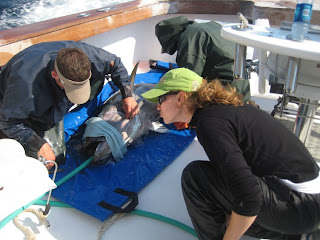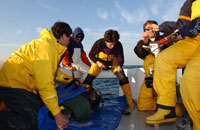Greetings from Porto
Barricata! On Thursday, Dr. Pablo
Cermeno (
WWF) and I arrived in Italy where we were warmly greeted by our gracious host Daniele
Crepaldi. Daniele then whisked us to the port for the tournament briefing for the 2
nd Edition of the Porto
Barricata Fishing Club Tuna Tournament Tag (sic). There were a lot of eager faces and a lot of interest in Tag-A-Giant.
Friday, our first fishing day, was beautiful and over 45 boats fished during day-one of the tournament. Unfortunately, the fishing was slow, but we successfully tagged one 153 cm (60-inch)
bluefin tuna that was transferred to us from the "Hook-up," a beautiful 32' Boston Whaler Outrage with twin 275 hp
Mercs. Daniele, the tournament organizers, the TAG crew and the fishers alike were all excited about this tag deployment.
Unfortunately, the weather did not cooperate for day-two of the tournament, and Saturday was cancelled.
We were able to fish on Sunday on Daniele's boat the "Kahuna," with five other boats from the port pledging to transfer us any captured fish. The slow fishing persisted and neither we, nor our five collaborating vessels, hooked any tunas.
Not dissuaded, we attempted to fish again today, Monday, but an Adriatic storm brewed up, forcing us to retreat to the port.
Currently, it is very windy, but we are hoping to get out one last day on the water tomorrow before both Pablo and I must leave this beautiful place on Wednesday.
Dr. Andrew
SeitzProfessor, University of Alaska, Fairbanks
On location for TAG in Porto
Barricata, Italy










 Map shows the track from an 8-1/2 foot long Atlantic bluefin tuna tagged off Nova Scotia that swam into the Gulf of Mexico, spent several weeks in the spawning area, then departed (yellow track). The dark blob off Louisiana is the estimated coverage area of the oil spill as of May 3.
Map shows the track from an 8-1/2 foot long Atlantic bluefin tuna tagged off Nova Scotia that swam into the Gulf of Mexico, spent several weeks in the spawning area, then departed (yellow track). The dark blob off Louisiana is the estimated coverage area of the oil spill as of May 3.































